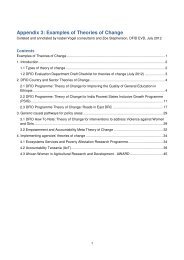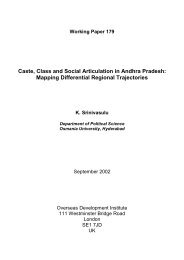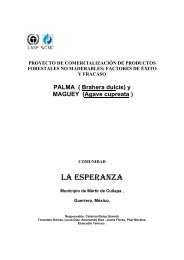Full Report - Research for Development - Department for ...
Full Report - Research for Development - Department for ...
Full Report - Research for Development - Department for ...
Create successful ePaper yourself
Turn your PDF publications into a flip-book with our unique Google optimized e-Paper software.
(Philips et al., 2004) was available to assess the quality of economic evaluations<br />
based on a synthesis of effectiveness data from a range of papers and the<br />
construction of different <strong>for</strong>ms of economic evaluation (Appendix 2.8).<br />
2.3.2 Overall approach to and process of synthesis<br />
The approach to synthesis was driven by the research question, the types and quality<br />
of studies and the data included in the review. Heterogeneity of study design,<br />
population and intervention precluded statistical meta-analysis. The most<br />
appropriate approach – a textual narrative synthesis – was conducted. Because our<br />
review question involves two linked but distinct populations – mothers and infants –<br />
we have structured our review accordingly. For a subset of high-quality items, we<br />
conducted a causal chain analysis, also separated according to whether the outcome<br />
was maternal or infant mortality.<br />
2.3.3 Selection of studies <strong>for</strong> synthesis<br />
The narrative synthesis includes all eligible studies on the basis of the<br />
inclusion/exclusion criteria. The causal change analyses are restricted to studies<br />
identified as high quality.<br />
2.3.4 Selection of outcome data <strong>for</strong> synthesis<br />
Outcomes included maternal and infant health outcomes: maternal, infant,<br />
neonatal, perinatal, post-neonatal mortality, and still-birth; and severe acute<br />
maternal morbidity (SAMM) (haemorrhage, dystocia, hypertension, sepsis,<br />
incomplete abortion, Caesarean section (CS), hysterectomy and blood transfusion)<br />
(World Health Organization, 2011b).<br />
This review focuses on maternal and infant mortality outcomes. Process indicators,<br />
such as skilled care at birth, are often used as substitutes <strong>for</strong> mortality outcomes<br />
whose measurement poses considerable challenges. However, mortality outcomes<br />
are not necessarily improved where gains in individual process indicators are not<br />
accompanied by broader changes (Koblinsky et al., 1999). A focus on mortality<br />
outcomes is thus crucial, particularly in areas where the mortality burden is high<br />
(Campbell and Graham, 2006; Bhutta et al., 2008; Lawn et al., 2009).<br />
2.3.5 Synthesis of evidence<br />
All eligible studies were included within the qualitative analysis to establish a<br />
detailed picture of the available evidence. We first analysed the data using EPPI-<br />
Reviewer 4 and generated comprehensive tables <strong>for</strong> each code. All tables were then<br />
exported and merged in Excel 13 to produce a unique results table.<br />
Narrative synthesis was the principal approach used. Eligible studies were grouped<br />
into type of interventions – broadly grouped into clinical and non-clinical – as<br />
described later on in the report. Findings were analysed within each category <strong>for</strong> the<br />
two main target populations: mothers and infants, including neonates. While most<br />
systematic reviews focus on synthesising evidence on effectiveness from quantitative<br />
research, we wanted to develop the contribution that can be made by different<br />
types of evidence, including that involving qualitative data.<br />
In addition, causal chain analysis was per<strong>for</strong>med on included studies identified as<br />
high quality to allow the extraction and illustration of the casual path emerging from<br />
our review, linking reasoning <strong>for</strong> intervention, with experience, implementation and<br />
sustainability. We used an approach based on White’s (2009) theory-based impact<br />
evaluation, and drawing on the realist review approach of Pawson et al. (2005),<br />
13 http://office.microsoft.com/en-us/excel/<br />
Methods<br />
What are the effects of different models of delivery <strong>for</strong> improving maternal and infant health<br />
outcomes <strong>for</strong> poor people in urban areas in low income and lower middle income countries? 20









